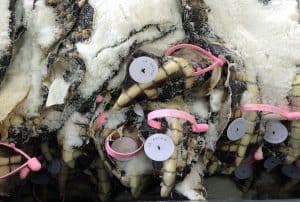La Patrie is a company specialising in the tanning and finishing of fine leather, including crocodile, ostrich and python, metal-free and eco-friendly. Located in the heart of the Tuscan Leather District, the company was founded in 2015. In order to keep faith with a mission oriented towards the principles of eco-sustainability and high quality, since 2016 La Patrie has adopted RFID technology, thanks to which it automatically monitors the progress and guarantees the unequivocal traceability of each individual leather, from the moment it enters the plant in the province of Pisa to the moment it leaves, with destination to the various customers in the high fashion chain.
How Rfid works in La Patrie production
 The solution starts working when the leather arrives at the Tuscan plant from the farms in the USA: after visual quality control, the operator attaches the special Rfid Tag to each individual skinby riveting. Henceforth, the product has its own, unique electronic identity. Along the processing line, each hide is automatically detected in the 9 RFID stations scattered throughout the plant.
The solution starts working when the leather arrives at the Tuscan plant from the farms in the USA: after visual quality control, the operator attaches the special Rfid Tag to each individual skinby riveting. Henceforth, the product has its own, unique electronic identity. Along the processing line, each hide is automatically detected in the 9 RFID stations scattered throughout the plant.
Production steps monitored by Rfid include:
- shaving, where the Long Range Reader RFID LR1002, connected to an antenna, operates;
- drying, whose system is controlled by 2 controllers, each connected to DAT (Dynamic Antenna Tuner Board) antennas. Using this device, the antennas can be easily calibrated via software, optimising their performance even in the presence of electromagnetic interference;
- both automatic and manual painting, where the LR1002 controllers are connected, via multiplexers, to 3 ANT 800×600 DAT antennas in overlapping, to ensure a constant RF field across the width of the installation.
To better meet La Patrie's operational needs, a smart trolley was also set up, incorporating RFID technology and related accessories (RFID LRM2500 controller connected, via multiplexer, to 3 Custom DAT antennas): the hides, poured by the operator into the trolley, are identified in a massive and automatic way, then transported to the drum, the machinery for tanning the hides, on which an RFID tag is fixed. Such an RFID architecture makes the trolley intelligent, tracking the movement of the hides through all the processing phases and associating them with the correct drum, i.e. responsible for tanning that specific hide.
Criticalities and advantages of application
The use of RFID technology has made it possible to guaranteeeffective and reliable traceability of the product throughout the entire production process. The anatomical characteristics of the tags have ensured that their implementation in the most delicate transformation processes does not damage the hides, guaranteeing maximum product quality. The Rfid tunnel is also being implemented to detect the entry of hides coming from the USA, while in the near future the tags will be affixed in America, allowing them to be detected on arrival at the Tuscan plant, when they will be laid down on the conveyor belt and automatically identified by the integrated Rfid system (the LR2500 Long Range Reader is connected, via multiplexer, to 3 Custom DAT - Dynamic Antenna Tuner Board - antennas).
Luca Arietti, RFID & BLE Sales Engineer at RFID Global - Gruppo Softwork, who oversaw the project, says: "La Patrie's experience testifies to the value of Engineering Services, which was deployed to design and implement ad hoc RFID structures, i.e. the trolley and the tunnel, for reliable, agile traceability in line with production operations".
The RFID architecture at La Patrie operates in the HF band, the only one that meets the expectations of mass identification and traceability in the Tuscan factory: the leather by its nature absorbs the electromagnetic waves of UHF, which is therefore the wrong band.
The biggest challenge RFID faced in this project was the tag itself: which tag, in terms of size, thickness and resistance to chemicals, could perform correctly, with 100% traceability of each hide, and be economically viable? Special Round Tags were chosen: almost 200,000 special round PVC tags, plastic-coated to withstand tanning and riveted to the leather.
As Leonardo Traversi, Managing Director at La Patrie, concludes: "The high strength characteristics of the RFIDs, such as the anatomical characteristics that guarantee the highest quality of the products without damaging them, are undoubtedly a strong point and an essential element for their application in the production process. The traceability objectives and expectations of the rounds are fully met.
You might also be interested in:
RFID technology enters the Teatro Regio di Parma with Murata



















